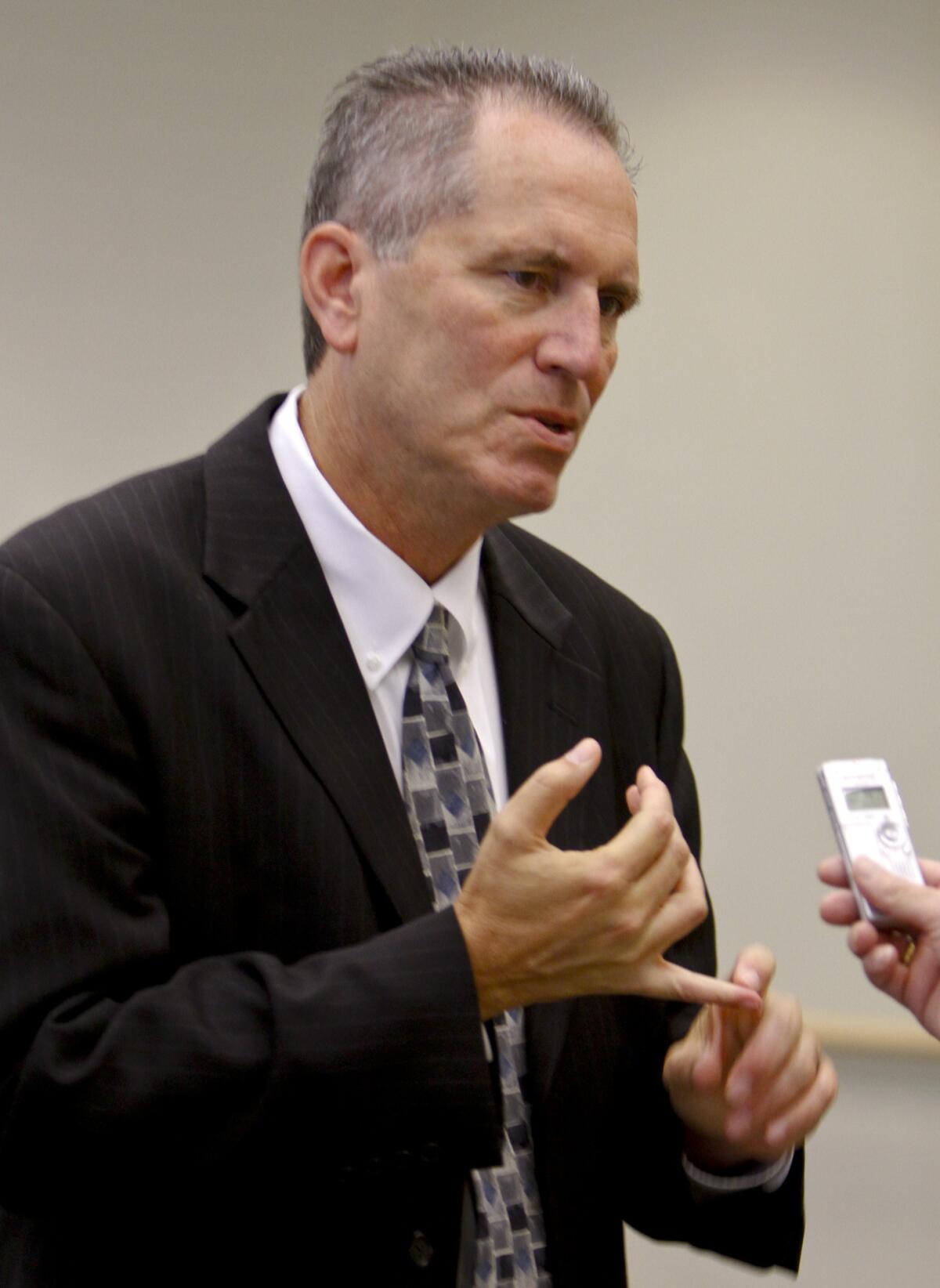Incidents expose flaws in civilian oversight of Sheriff’s Dept.

- Share via
Revelations of brutality by Los Angeles County sheriff’s deputies and cover-ups inside the jails have exposed significant shortcomings in the department’s civilian watchdog system, which was created to prevent such misconduct.
The watchdogs have come under scrutiny from county supervisors and investigators for a commission examining jail abuse. The investigators found that neither of the two main civilian monitors regularly analyzed data that tracks violent encounters between deputies and inmates or examined how the department handled inmate complaints.
When the watchdogs did uncover major problems in the jails, the investigators found, the Sheriff’s Department failed to carry out some of the recommended reforms.
FULL COVERAGE: Jails under scrutiny
“You can’t expect civilian oversight to fix all of the problems,” said Peter Eliasberg, legal director of the American Civil Liberties Union of Southern California. “But in some ways, they’ve been counterproductive because they’ve given the sheriff a patina of respectability that he wasn’t entitled to.”
The calls for improving civilian oversight come after the commission’s investigators concluded that sheriff’s managers allowed and even fostered an aggressive culture in the jails, and deputies used excessive force and humiliated inmates.
L.A. County has the largest jail system in the country, housing approximately 19,000 in eight facilities.
The jail problems have festered even though the department has long been praised as a leader in civilian oversight. Sheriff Lee Baca frequently defends the department by noting that he pushed for the creation of one of those monitors, the Office of Independent Review.
The office, which reports to the Board of Supervisors, is made up of attorneys who examine disciplinary cases involving deputies and is led by Michael Gennaco, a former federal prosecutor. The department’s other civilian monitor is Merrick Bobb, a special counsel to the Board of Supervisors who writes regular reports on department operations. Both Gennaco and Bobb are well regarded in their field.
Investigators for the blue-ribbon commission praised both watchdogs for identifying crucial problems in the jails and offering proposed fixes.
“There are recommendations that, had they been implemented, clearly could have ameliorated the problems that we see today,” said Miriam Krinsky, the commission’s executive director.
In the wake of the jail abuse scandal, there is growing pressure to enhance oversight. On Friday, the county’s blue-ribbon commission is expected to propose sweeping changes, and its investigators have suggested giving the watchdogs expanded powers, including the ability to conduct their own investigations and maintain a permanent presence in the jails.
Three county supervisors said in interviews this month that they thought the Office of Independent Review was too close to the Sheriff’s Department.
Supervisor Zev Yaroslavsky said the office had become “literally and figuratively embedded” with the department. Supervisor Mark Ridley-Thomas said he was concerned that its attorneys had been “co-opted or compromised.”
“It’s gotten too cozy with the sheriff,” said Supervisor Gloria Molina. “They have had a tendency to acquiesce to too much.”
The supervisors are not the only ones to question Gennaco’s independence. Attorney R. Samuel Paz, who has sued the department over its treatment of inmates, noted that under the current contract with the county, Gennaco, as chief attorney for the Office of Independent Review, has an “attorney-client” relationship with Baca. Gennaco said such language was necessary to keep discussions about disciplinary matters with the sheriff and his staff confidential.
The ACLU’s Eliasberg praised Bobb’s efforts to unearth problems in the jails but said the department had used Gennaco as a public relations tool to fend off criticism. (The ACLU has been appointed by a federal court to help monitor inmate welfare.)
Gennaco defended his office’s record, saying its work had led to the firings of about 50 deputies who would otherwise have kept their jobs despite serious misconduct. The department’s internal affairs investigations were once uneven but now surpass professional standards, he said. And he pointed to several past reports in which he identified jail problems, including shoddy and biased investigations, saying the department had been slow at times to follow through.
“I am critical of [the Sheriff’s] Department when they deserve to be criticized,” he said.
County supervisors have thought highly enough of Gennaco in recent years to ask his office to investigate problems in the probation and child welfare departments.
Bobb said that both he and Gennaco had identified major problems in the jails over the years and would have done more but for their limited budgets.
The two watchdogs are dwarfed by the Los Angeles Police Department’s civilian monitor, the inspector general, who has a staff of 35 to 40 and a budget of about $6.2 million. By contrast, Bobb works with two others on a budget of about $300,000, while the Office of Independent Review has six attorneys with a budget of about $1.3 million.
Bobb said the Sheriff’s Department failed to heed much of his advice on improving the jails.
Among his suggestions was for deputies to stop using heavy metal flashlights against inmates and for the department to begin random stings to root out corrupt employees. The department did not implement the reforms and revisited them last year after sheriff’s officials learned that federal agents had used a corrupt deputy to smuggle a cellphone to an inmate who was helping the FBI with an investigation into allegations of brutality by deputies.
“I can make all the recommendations I want, but if the sheriff doesn’t implement them, it doesn’t matter,” Bobb said.
Civilian oversight advocates say it’s an achievement for a law enforcement agency to have one watchdog, let alone two.
Bobb was hired by the Board of Supervisors after he led an investigation into the department that in 1992 found “deeply disturbing evidence of excessive force and lax discipline” by deputies. Nearly a decade later, Baca reacted to an unfolding corruption scandal at the Los Angeles Police Department by proposing the creation of the Office of Independent Review to examine how his own department was handling allegations of misconduct.
Nonetheless, Baca appears at times to have dismissed watchdog findings.
In a 2005 deposition, the sheriff questioned Bobb’s qualifications after the special counsel criticized the actions of jail deputies that led to the death of an inmate and the department’s subsequent investigation. “He has no background for jail operations,” Baca said. “I think Mr. Bobb is fishing in deep water.”
Sheriff’s spokesman Steve Whitmore rejected the idea that Baca was not interested in the findings of civilian monitors, saying he took their suggestions seriously. And he disputed criticism that the department had ignored or was slow to carry out reforms.
“These things take time to put into place. It can’t be done overnight,” Whitmore said.
Civilian oversight advocates rejected any suggestion that Los Angeles County’s watchdogs had failed, arguing that Gennaco and Bobb’s good work is not a substitute for strong leadership by police brass.
Sam Walker, a police accountability expert at the University of Nebraska at Omaha, said he thinks highly of both of the sheriff’s main monitors and suspects the problem with jail abuse lays outside their scope, stemming from “something inherent about the L.A. County jail,” such as the high percentage of mentally ill or drug-addicted inmates, or the sheer size of the jail system.
“If you’re looking to some new or changed form of oversight, I think that’s misdirected,” Walker said.
More to Read
Sign up for Essential California
The most important California stories and recommendations in your inbox every morning.
You may occasionally receive promotional content from the Los Angeles Times.












